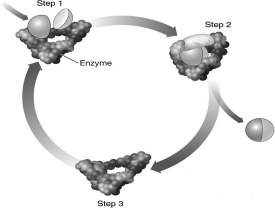Multiple Choice
The image below diagrams the action of an enzyme.Notice that the enzyme is depicted as being more tightly wrapped around the substrates in step 2 than it is in step 1.Why is this? 
A) When a substrate locks into the active site of an enzyme, the enzyme changes shape to mold itself around the substrates.
B) Generally, the size of a substrate is larger than the size of the active site into which it must fit. When the substrate enters the active site, the active site must stretch to fit.
C) Before catalysis can occur, a substrate must change its shape so that it fits into the active site of the enzyme more precisely.
D) Most active sites are only designed to hold one substrate. In this image, two substrates enter the active site, creating a tighter fit.
Correct Answer:

Verified
Correct Answer:
Verified
Q21: Which of the following is either consumed
Q43: The Krebs cycle produces<br>A) NADH, ATP, and
Q44: During exercise,the increase in respiration rate and
Q45: Defend the following statement by discussing the
Q47: For each characteristic below,determine if it applies
Q49: The chemical 3-(3,4-dichloro-phenyl)-1,1-dimethylurea (DCMU)blocks the movement of
Q50: For each characteristic below,determine if it applies
Q51: Is the burning of wood most representative
Q52: Which of the following is a similarity
Q53: In a human cell,<br>A) one enzyme usually